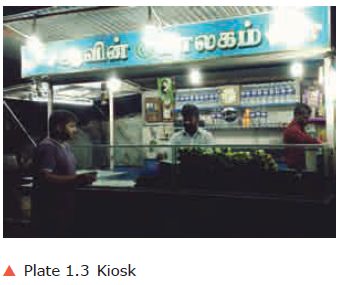Chapter: 11th Food Service Management : Chapter 1 : Food Service Operation
Food Service Operations
Food
Service Operations
Food service operations are
broadly cate-gorized as commercial and non-commercial.
1. Commercial
Commercial food service
operations are operated as business or for a profit motive Eg: hotels. The types of food service operations are many to meet
the demands of the cus-tomer and the following are some of the com-mon
commercial food service operations.

a. Cafeteria: Cafeteria system consists of straight-line counters containing a vari-ety of hot and cold dishes. The customers pick up a tray and move along and select the dishes. The cashier at the end of the counter makes the bill for items selected and collects payment. In India, in most cafeteria operations guests make payment at the cash counter before hand for items they want to eat.

The tables have the basic require-ments such as salt and pepper, straw
holder, napkins and water glasses. Cafeterias are situated in railway stations,
cinema halls, shopping complex and in premises of office, school and college
where guests expect quick service.
b. Coffee
Shop: It may be an independent outlet or situated in a restaurant. It mainly
serves snacks and beverages 24 hours a day.
The service and ambience are
informal.
The furniture and service equip-ment are not very expensive. Dishes
ordered by the guests are neatly plated in the kitchen, garnished and placed
before the guests.
c. Kiosk: A kiosk is a small permanent or temporary structure on a side walk.
Here items like coffee, tea, chocolates, pastries and savories are sold. The
items bought may either be taken away or consumed at tables arranged nearby.
Most kiosks do not have seating provisions.

d. Meals on Wheels: The concept of ‘Meals on wheels’ was developed in the United
Kingdom during World War II. It was in 1943 when food was delivered to
servicemen, in old prams using straw bales to keep the meals warm in transit.
The invention of meals on wheels which started as a voluntary programme has
reshaped and taken a new dimension of becoming a profit-making business in
recent times. This idea has been improvised in the modern day.
Food that is cooked in a central-ized kitchen is supplied to homes,
offices, hospitals and to elderly people who live in a community in separate
homes. Now-a-days restaurants supply food by taking orders from customers on
wheels. Meals are also prepared in centralized kitchens and supplied in buses,
trains and flights.
Assorted snacks and main meals
are prepared elsewhere and transported by vehicle to a central point and
served.
This type of outlet moves from
place to place or stationed near busy areas.
e. Airport Lounge: Airport lounge has a wide menu for breakfast, lunch, and
dinner with hot and cold beverages, sal-ads, main meals, and desserts. It also
has formal ambience, appealing for having meals at leisure and resting
gracefully at the airport. The traveler selects food and beverage of choice,
and takes to the table himself.

f. Family
Restaurant: Family restaurant has elaborate menu of single or multiple
cui-sines which may change according to the operating hours. They have good
ambience and comfortable seating arrangements so that the guests can dine
leisurely.
g. Fast
Food Outlets: Fast food outlet has limited menu of hot and cold beverages
with easily prepared and fast meals cooked in advance and kept warm. The
service must be speedy. The food is pre-pared in the kitchen, placed in the
trays, and passed to the customer.
h. Food
Court: Food court consists of multi-cuisine menu. Multi-cuisine food
outlets are located around with central dining. The customers pick up food and
beverages of their choice from multiple outlets around and sit in the central
din-ing area to consume. This type of food service can be seen in shopping
malls.
![]()
i. Theme Restaurant: Theme restaurants have limited menu that is based on the theme. Architecture, lighting, and music induce the feel of the theme. Mostly infor-mal ambience is maintained with various other interior decorations.



Robot Theme Restaurant: Introduction of novel ideas in production and service has taken the
industry to great heights. New themes with special ized services have taken a new momentum these days. The advancement of
technology has seen

Currently in
India, the first Robot theme restaurant with robots serv-ing food to the guests
at the table has emerged in Chennai.
2. Non-Commercial
Non-commercial food service operations could be defined as operations
includ-ing colleges and universities, healthcare, industries, military,
day-care centres, orphanages and old age homes which give free food and
accommodation. This segment prepares, serves food and sup-ports some other
establishment’s main function or purpose. For example, the caf-eteria in a
university supports the goal of educating students by serving them meals so
that they have the energy to partici-pate in class and other activities. Within
the noncommercial segment, food service is typically handled either by
contractors who will manage and operate the food and dining facilities or which is self
-operative, which means the institutions hire their own staff to operate food
services.
a. Welfare
Catering: The provision of food and beverages to people to fulfill a social
obligation is known as welfare catering. It includes catering in hospitals,
schools, colleges, the armed forces and industrial catering. In hospitals, the
patients are given nutritious food at a reasonable price so that the
convalescence period is not too long.
Schools and universities provide
on-campus food services to students and staff. Students stay as residents in
school hostels and eat from the mess or school food service.


b. Industrial Catering: The provision of food and beverages to ‘people at work,’ in industries and
factories at highly subsidized rates is called industrial catering. It is based
on the assumption that if employees are fed better they are happy and more
productive. Food is given at a concessional rate.

Related Topics